Cow milk handling and processing practices in Southern Ethiopia
BücherAngebote / Angebote:
Forschungsarbeit aus dem Jahr 2017 im Fachbereich Agrarwissenschaften, , Sprache: Deutsch, Abstract: The study was conducted in Kucha District of Gamo Zone, Southern Ethiopia to assess cow milk handling and processing practices. Purposive sampling technique was used to select the study district and kebeles and a total of 138 respondents were randomilly selected and interviewed. Focus group discussions were conducted separately in each selected kebeles to strengthen the survey data. The predominant milk production system in Ethiopia is the smallholder milk production system, which is mainly dependent on the indigenous zebu breeds of cow with low productivity, which produce about 1.37 liter of milk/cow/day. This system in the country is the subsistence oriented farming and the system is mainly grouped into pastoralists, agro-pastoralists and mixed crop-livestock producers. Milking cows in this sector have an average lactation length of 190 days and an average milk yield of 1.9 liters/day/cow. Even if this sector depends on indigenous breeds of low-producing native cattle, certain progressive small-scale farmers in the various milk sheds are now keeping cross-bred cows that are capable of producing 800 to 1200 liters of milk/cow/lactation and sell milk to co-operative societies and commercial milk collectors. The average cattle herd size in small holder milk production system is about 5.34 per household and out of this herd size, 1.87 consists of local cows and the rest represent other categories of cattle such as oxen, heifers, bulls and calves. Very few crossbred cows are kept in the rural dairy system as a result of feed shortage and difficult in management. The major focus of producers in this system is butter production rather than raw milk. In this system, animals are kept in open shed during the night and left on open grazing fields in all or part of a day.
Folgt in ca. 10 Arbeitstagen




